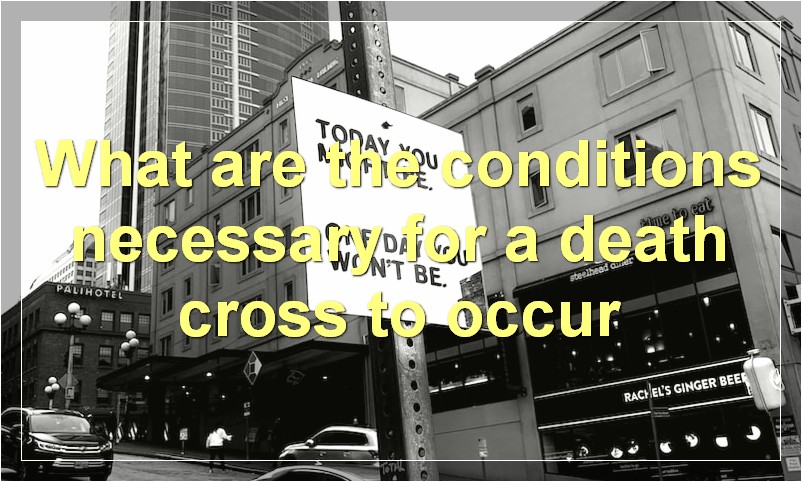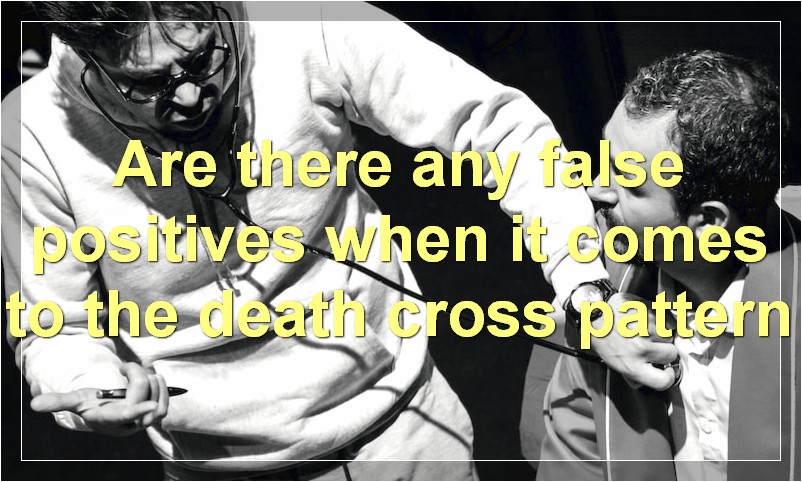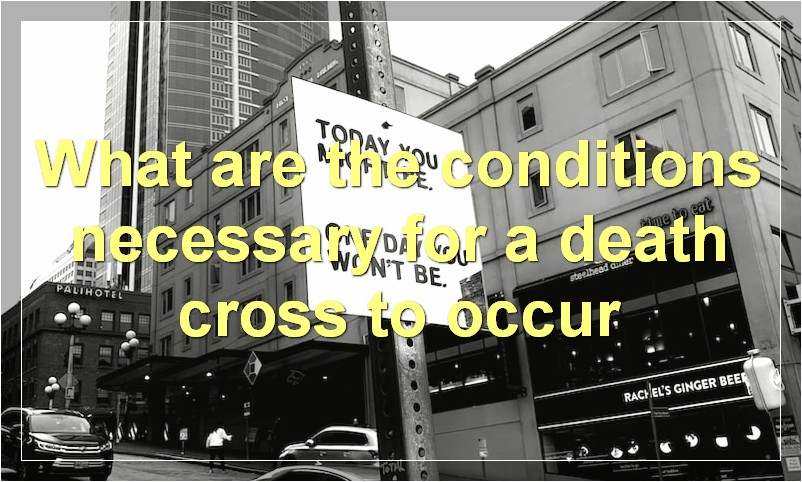The death cross pattern is a reliable indicator of a bear market, and investors need to be aware of it in order to make the best decisions for their portfolios.
What is the death cross pattern
When it comes to technical analysis, one of the most popular indicators is the death cross. This is a bearish signal that is created when the 50-day moving average crosses below the 200-day moving average.
The death cross is often seen as a sign that a long-term downtrend is about to begin, and as such, it can be a useful tool for traders who are looking to enter into short positions.
While the death cross is not necessarily a guaranteed indicator of future price movements, it is nonetheless a widely followed signal that should not be ignored.
What are the conditions necessary for a death cross to occur

In order for a death cross to occur, two conditions must be met. First, the 50-day moving average must cross below the 200-day moving average. Second, both averages must be declining.
A death cross is a technical indicator that is used to signal that a stock is in a long-term downtrend. It is important to note that a death cross can occur in any time frame, but it is most commonly used on daily charts.
There are two key conditions that must be met in order for a death cross to occur.
First, the 50-day moving average must cross below the 200-day moving average. A moving average is simply a metric that smooths out price action by creating a single line that represents the average price of a security over a given period of time. The 50-day and 200-day moving averages are two of the most commonly used averages in technical analysis.
Second, both averages must be declining. This means that the stock is in a long-term downtrend. A death cross signals that the trend is likely to continue lower.
While a death cross can be a useful indicator, it is important to remember that it is not infallible. There have been times when stocks have continued to rally after forming a death cross. As with all technical indicators, it is important to use other tools in order to confirm the signal.
Why is the death cross considered bearish
The death cross is considered bearish because it typically signals the end of a bull market and the beginning of a bear market. The death cross occurs when the 50-day moving average crosses below the 200-day moving average. This is seen as a bearish signal because it indicates that the shorter-term trend is now bearish, and that the longer-term trend may also be about to turn bearish.
The death cross can be a useful indicator for traders and investors who are looking to get out of the market or take a more bearish stance. However, it is important to remember that the death cross is not a perfect indicator, and there have been times when it has signaled a bear market when there was none, or vice versa.
How can traders use the death cross to their advantage
When a death cross forms, it can be used as a bearish sign by traders. This is because the death cross indicates that the 50-day moving average has crossed below the 200-day moving average, which is often seen as a sign of a long-term trend change.
Traders who are looking to take advantage of a death cross can do so by selling their positions or shorting the market. If a trader is looking to short the market, they can do so by using a variety of technical indicators to help them identify when the market is ripe for a short.
One indicator that traders can use is the Relative Strength Index (RSI). The RSI is a momentum indicator that measures whether a stock is overbought or oversold. A stock is considered overbought when the RSI is above 70 and oversold when it falls below 30.
The RSI can be used to confirm a death cross signal. For example, if the RSI is above 70 and the 50-day moving average crosses below the 200-day moving average, this could be confirmation that the market is indeed bearish and ripe for a short.
Another indicator that traders can use to confirm a death cross signal is the Moving Average Convergence Divergence (MACD). The MACD is a momentum indicator that uses two exponential moving averages (EMAs) to measure whether a stock is overbought or oversold.
The MACD is calculated by subtracting the 26-day EMA from the 12-day EMA. A buy signal is generated when the MACD line crosses above the signal line and a sell signal is generated when the MACD line crosses below the signal line.
The MACD can be used to confirm a death cross signal in two ways. First, if the MACD line crosses below the signal line while the 50-day moving average is still above the 200-day moving average, this could be confirmation that the market is bearish and ripe for a short.
Second, if the 50-day moving average crosses below the 200-day moving average while the MACD line is still above the signal line, this could also be confirmation that the market is bearish and ripe for a short.
In conclusion, death crosses can be used as bearish signals by traders. Traders who are looking to take advantage of this signal can do so by selling their positions or shorting the market. To confirm a death cross signal, traders can use indicators such as the RSI or MACD.
What other technical indicators can be used in conjunction with the death cross
The death cross is a technical indicator that is used to signal the potential for a bearish market trend. It is created when the 50-day moving average crosses below the 200-day moving average. This indicates that the short-term trend is now bearish and that the long-term trend may soon follow suit.
Other technical indicators that can be used in conjunction with the death cross include the Relative Strength Index (RSI) and the Moving Average Convergence Divergence (MACD). The RSI can help confirm the trend change by showing whether momentum is still bullish or has begun to turn bearish. The MACD can also confirm the trend change and provide additional information on the strength of the trend.
Are there any false positives when it comes to the death cross pattern

When it comes to the death cross pattern, there can occasionally be false positives. This means that the pattern may indicate that a stock is about to experience a downturn, when in reality it is not. While false positives are not common, they can happen. As such, it is always important to do your own research before making any investment decisions.
What is the difference between a death cross and a Golden Cross
In the financial world, a death cross and a golden cross are two terms that are used to describe different things. A death cross occurs when the 50-day moving average crosses below the 200-day moving average. This is seen as a bearish signal and is often used by traders to indicate that a stock is in a downtrend. A golden cross, on the other hand, occurs when the 50-day moving average crosses above the 200-day moving average. This is seen as a bullish signal and is often used by traders to indicate that a stock is in an uptrend.
Can the death cross be used as a standalone indicator
The death cross is a technical indicator that is used by some traders to signal that a market is about to enter a bearish phase. While the death cross can be an accurate predictor of a market reversal, it should not be used as a standalone indicator. Instead, traders should use the death cross in conjunction with other technical indicators and market analysis techniques.
How reliable is the death cross pattern
The death cross pattern is a technical analysis indicator that is used to signal the potential for a bearish market reversal. The death cross occurs when the 50-day moving average crosses below the 200-day moving average. This crossover is considered to be a bearish signal that indicates that the short-term trend is shifting down into a longer-term downtrend.
While the death cross pattern can be a useful tool for identifying potential market reversals, it is important to remember that it is not a perfect indicator. There are times when the death cross pattern will generate false signals, so it is important to use it in conjunction with other technical analysis indicators to confirm a bearish trend reversal.
What are some common misconceptions about the death cross pattern
There are many misconceptions about the death cross pattern, which is a technical analysis tool used by traders to identify potential reversals in the markets. Some believe that the death cross is only applicable to stocks, when in reality it can be used for any asset, including forex and commodities. Others think that the death cross is always bearish, when in fact it can be either bullish or bearish depending on the market conditions. Finally, some believe that the death cross is a surefire indicator of a market reversal, when in reality it is only one tool among many that traders use to make trading decisions.

